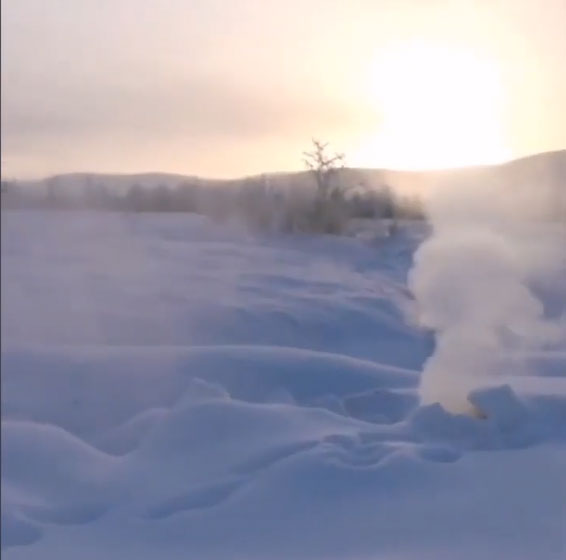Russia: 'Zombie fire' burns in a cold place of -50 degrees Celsius
The photographer captured smoke rising from an underground fire fueled by peat and methane, while ice covered the ground.
Semyon Sivtsev, a photographer from the village of Oymyakon, Yakutia, Russia, recorded the scene of smoke rising from the completely frozen ground, Interesting Engineering reported on December 9. Oymyakon has colder winters than any other city in the world with an average temperature of about -50 degrees Celsius. It is considered the coldest inhabited place on Earth. The lowest temperature record in Oymyakon is - 67.7 degrees Celsius, recorded in January 1924.
Although Oymyakon means "water that doesn't freeze" due to a nearby hot spring, the village is located in a permafrost area, meaning that the soil temperature is always below 0 degrees Celsius and snow is always covered.
Despite the low temperatures, peat fire or "zombie fire" fueled by peat and methane continues to burn underground. This means the underground fire can revive when the weather is dry.

Despite the low temperatures here, the zombie fire continued to burn underground.
"I recorded the smoke rising near the grassland adjacent to the village of Khara Tumul, not far from Oymyakon. That's where the forest fires happen in the summer," Sivtsev said. Forest fires in Tomponsky district, Yakutia, which began in May this year, prompted Russian authorities to declare a state of emergency in northeastern Siberia. The fires have consumed 18.16 million hectares of forest this year and are still burning underground during the winter.
There was a case of zombie fire burning in nearby Mundullakh for several years, according to Sivtsev. "The fire was then extinguished by a combination of melting snow and heavy rain, and a lake formed four years ago. The peat burned away and water took its place. This was also helped by the closed soil layer. the permafrost melts and in the last few years we've had heavy rains in the summer. Only last summer was relatively dry," he added.
With carbon-rich soil, formed by slowly decomposing plants over thousands of years, fires like these could generate up to 244 million tons of CO2. Scientists have also found that the occurrence of zombie fires is closely related to climate change. The data shows that they appear after wildfires during hot, long summers.
- Bac Bo was sunk in cold weather, Hanoi 14 degrees Celsius
- Russia: 45 people died from the cold price of -50 degrees Celsius
- Treatment for cold burns
- Cold air strengthens, the North is at least 2 degrees Celsius
- The North received more cold spells, many places below 13 degrees Celsius
- Surviving the winter, mysterious zombie fire returns to threaten 'melting' the Arctic
- The first aid for burns
- Temperatures in the Northern provinces are down to 14 degrees Celsius
- The deserted house 'snowy palace' because of the negative price of 61 degrees Celsius in Russia
- Russia experienced the coldest day in winter
- Visit the village cold -71 degrees Celsius
- How will the body change when the temperature drops to 10 degrees Celsius?
 The truth about the mysterious red-haired giant at Lovelock Cave
The truth about the mysterious red-haired giant at Lovelock Cave Inunaki Tunnel: The haunted road leading into Japan's 'village of death'
Inunaki Tunnel: The haunted road leading into Japan's 'village of death' The mystery of the phenomenon of human reflection before dying
The mystery of the phenomenon of human reflection before dying 6 mysterious phenomena, although science has been developed for a long time, still cannot be answered
6 mysterious phenomena, although science has been developed for a long time, still cannot be answered